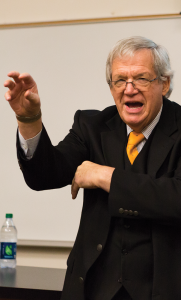
GUCR and GUCD attract prominent speakers like Dennis Hastert.
The generalization of colleges as being bastions of liberalism is a stereotype that’s here to stay at 37th and O streets.
A March 28 Gallup poll indicated a growth in youth identifying an affinity for the Democratic Party, currently resting at 53 percent. The Democratic Party’s attraction to students is no novelty, with Georgetown boasting a robust presence of college Democrats. But with the stuttered rollout of the Affordable Care Act’s and President Obama’s apparent mishandling of environmental issues, the poll flies in the face of critics claiming that Democrats are losing touch with their largest demographic: young voters.
By the measure of emails sent out to interested students, the College Democrats, which sent out emails to over 2,000 students, is the largest group on campus. The group also over 100 leadership positions. In comparison, the College Republicans’ Listserv numbers around 1,000 students.
According to the College Democrats, the size of these groups reflects the overall political alignment of Georgetown students.
“I think the fact that we do have the largest group on campus does tell a lot about where people’s political beliefs lie,” College Democrats Treasurer Anirudha Vaddadi (SFS ’16) said.
College Republicans members attribute the discrepancy in popularity to the character of a university.
“I think by nature, universities are liberal institutions. … That’s been a trend forever, as long as I know of. It doesn’t surprise me in that way that Georgetown is liberal,” College Republicans Vice-Chair Abbey McNaughton (COL ’16) said. “In general, I think the university as an institution often times has a liberal population, whether that’s undergraduates, graduates, professors.”
According to McNaughton, the university’s Jesuit identity additionally adds to its perceived liberal atmosphere.
“I would say that, if anything, Georgetown being Jesuit — not specifically Catholic, just Jesuit — has an influence just because of the Jesuit focus on social justice issues that often steer people more to the left,” McNaughton said.
However, according to College Democrats Chair Chandini Jha (COL ’16), this perceived liberal atmosphere is because of progressive ideas that align with changing social values among students.
“I think the issue really is just the social construction of things like marriage equality and women’s rights that attract more people to the Democrats as being the more progressive party on those issues,” Jha said.
Although College Republicans recognize the predominance of liberals on campus, members see a potential shift in the campus’s alignment.
“I think that college students on margin will always trend toward the more liberal persuasion; however I expect there to be a resurgence in young conservatism in the next few years, as we see the effects of the current administration,” College Republicans Chair Patrick Musgrave (COL ’16) wrote in an email.
McNaughton additionally felt that the effects of current political occurrences may shift political alignment in the future.
“When implications of Obamacare and the Social Security structure that is going to hurt our age group the most right now, I think that when those realities start to hit in, certainly the young republicans will definitely expand,” McNaughton said.
However, if the political alignment of members on campus grows in the future, College Republicans do not necessarily feel the size of the group would accurately reflect the conservative presence on campus.
“Maybe our particular group won’t grow, but across campus it will be more common to run into conservatives,” McNaughton said.
For both groups, size causes difficulties. For example, the large size of the Democrats leads to some difficulties in keeping a close-knit atmosphere.
“Our big issue in the club is just making sure that we can connect all our members in a way that makes it feel like a community,” Jha said. “A byproduct of our success is that we want to have the community feel of a smaller club.”
College Democrats are also careful about not speaking for their diverse and large group.
“We don’t want to speak for all of our members, given that we are such a big club, so that’s something that we are very aware of and try to be careful of,” Jha said.
For the College Republicans, the small size of their group does not restrict their liberty in programming and presenting their views.
“I don’t think there’s any substantial inequality in terms of what we are able to program for or in terms of being able to hold enough events,” McNaughton said.
However, as the smaller group, College Republicans face more voices ready to challenge their policies.
“I think maybe there’s more outspoken disagreement with some of our policies with the Republican Party on campus, but it doesn’t affect my engagement in the organization,” McNaughton said.
Students did seem to identify a lean toward the left among the student body.
“I think the College Democrats are probably more present on campus just because I feel like the student body itself is composed of more liberal leaning students,” Joey Shive (COL ’17) said. “College students are very focused on social atmosphere, and I feel that liberals tend to put that out there a lot more so it’s just a very activist atmosphere and a lot of those people are fighting for, it’s not necessarily a financial perspective, it’s more like a social opinion.”
Thomas Massad (COL ’17) concurred, attributing this appearance to marketing.
“I feel the College Democrats more on campus through the means of social media and through the means of more extensive flyering around campus, and in that way they are more visible to me in my day-to-day activity,” Massad said. “We have such a young population and I think peoples’ political views are more outwardly expressed and I see in my day-to-day interactions with other people and day-to day activity around campus, generally more liberal outspoken viewpoints as opposed to outspoken conservative viewpoints.”














